Abstract
The antigen that causes killing of at least 98% of a human cell population treated with a 1% solution of a specific rabbit antiserum in the presence of complement is a sensitive genetic marker. The rapid loss of human chromosomes in human-Chinese hamster cell hybrids makes possible a convenient test of linkage relationships with this marker. Hybrid clones with and without the lethal antigen were isolated and analyzed. In 76 clones and subclones studied, 41 carried both the lethal antigen and the lactic dehydrogenase-A marker, 35 carried neither, and no clones contained only one of the two markers. In contrast to this clear demonstration of linkage, absence of linkage was found between the lethal antigen and the following markers: Lactic dehydrogenase B, NAD-dependent malic dehydrogenase, NADP-dependent malic dehydrogenase, glucose-6-phosphate dehydrogenase, phosphoglucomutase, glutamate oxaloacetate transaminase, indophenol oxidase, glucose phosphate isomerase, proline, inositol, hypoxanthine B, and glycine A. This lethal antigen appears to be carried on a single human autosome.
Keywords: lactic dehydrogenase, auxotrophic mutations, Chinese hamster cells, single cell plating, human cells
Full text
PDF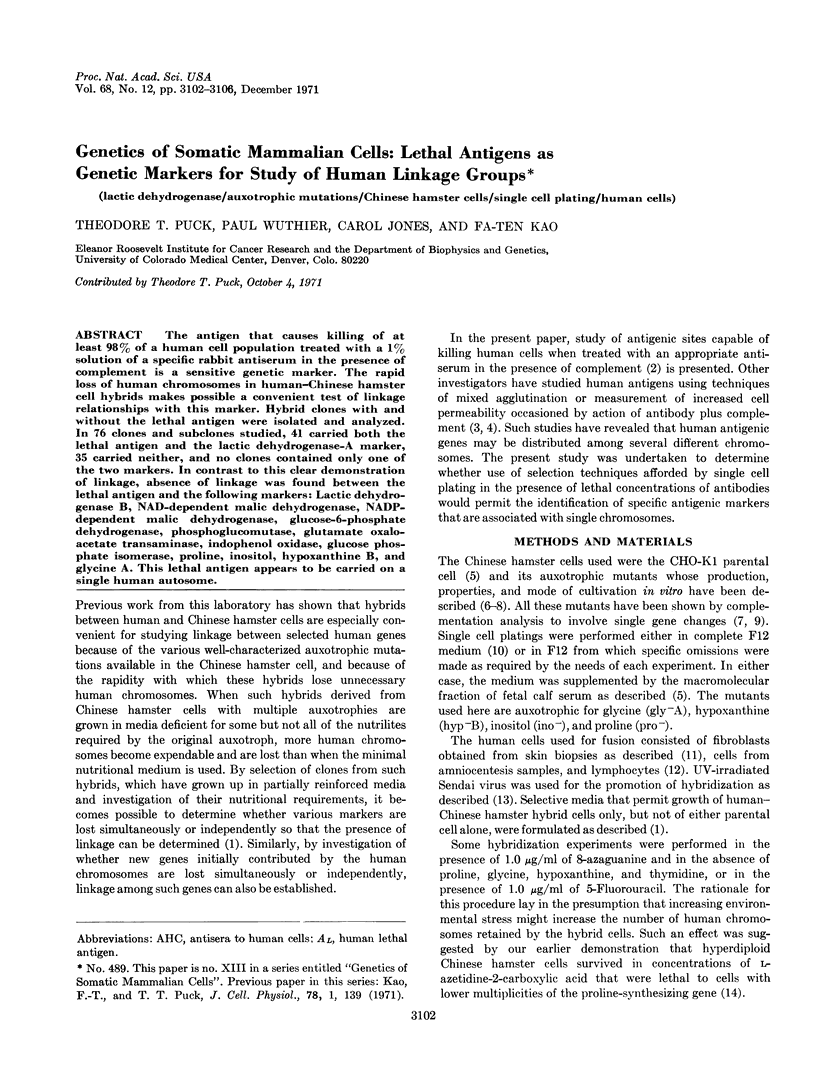
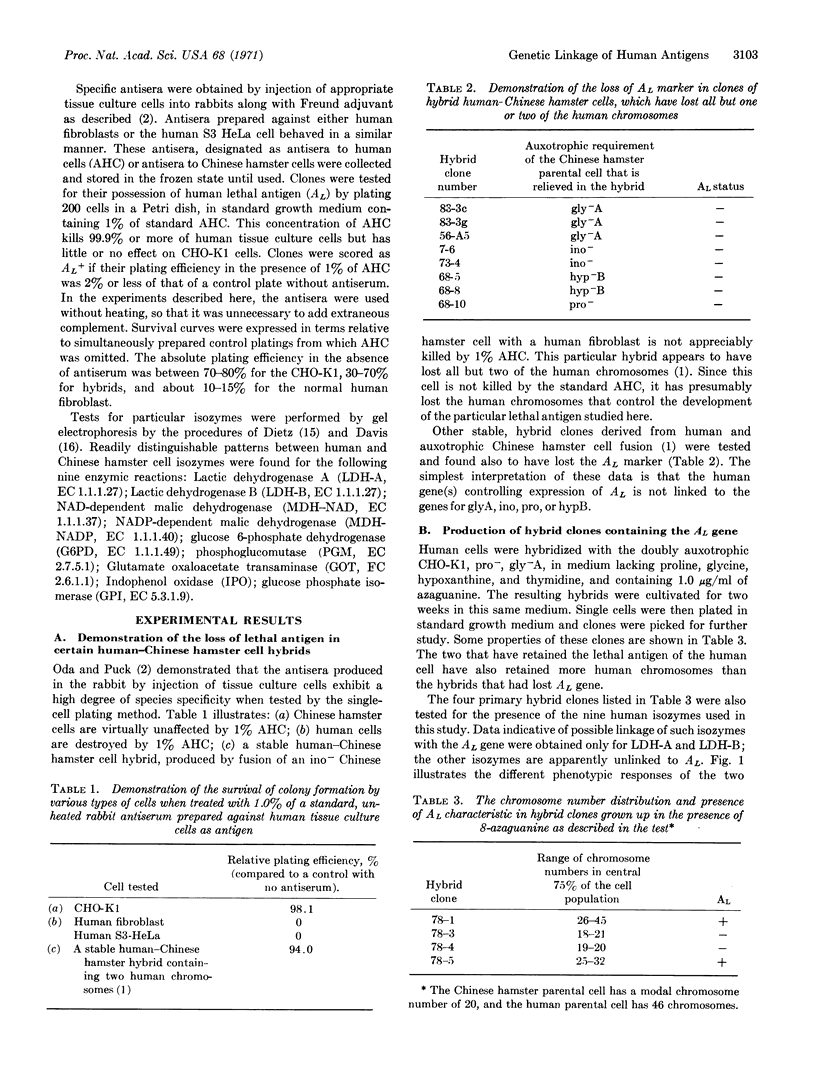
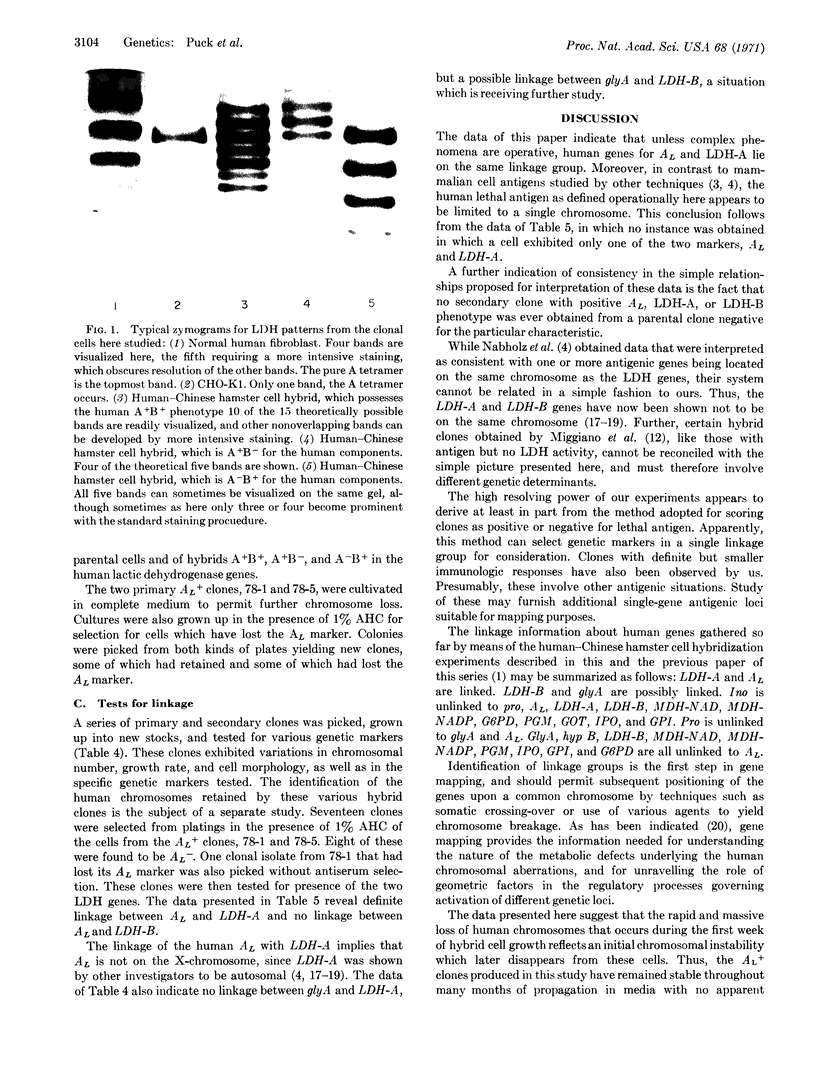
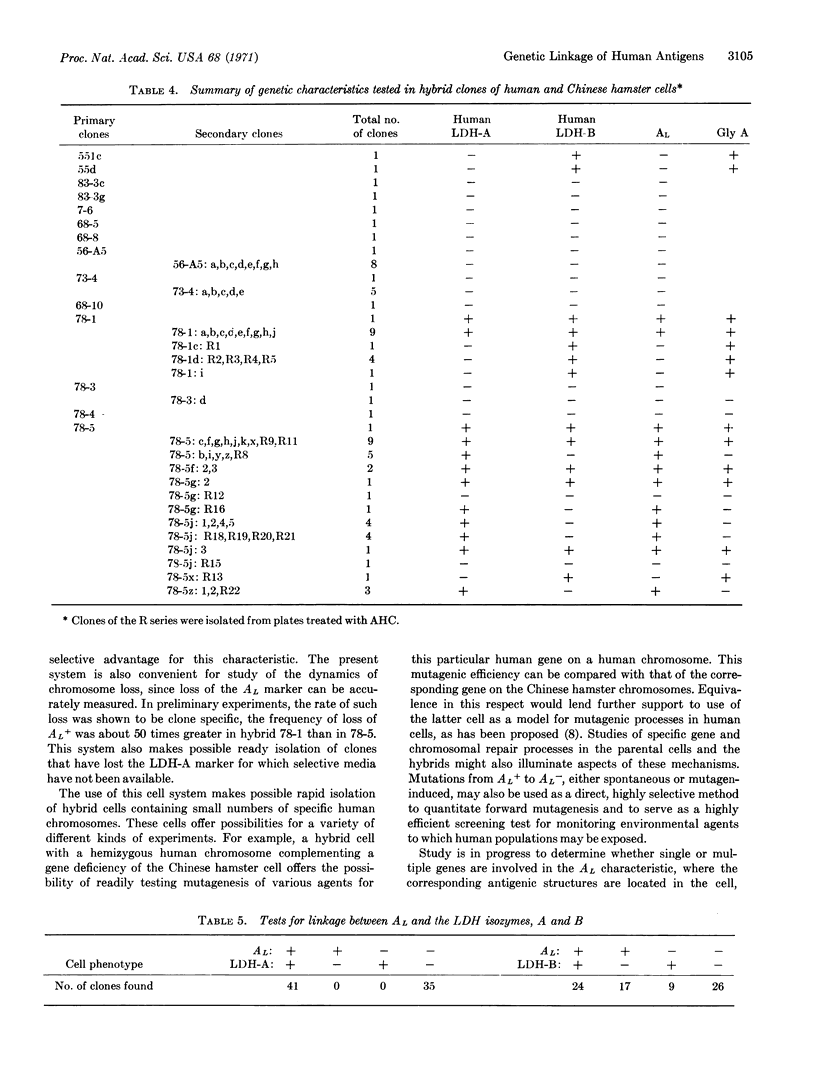
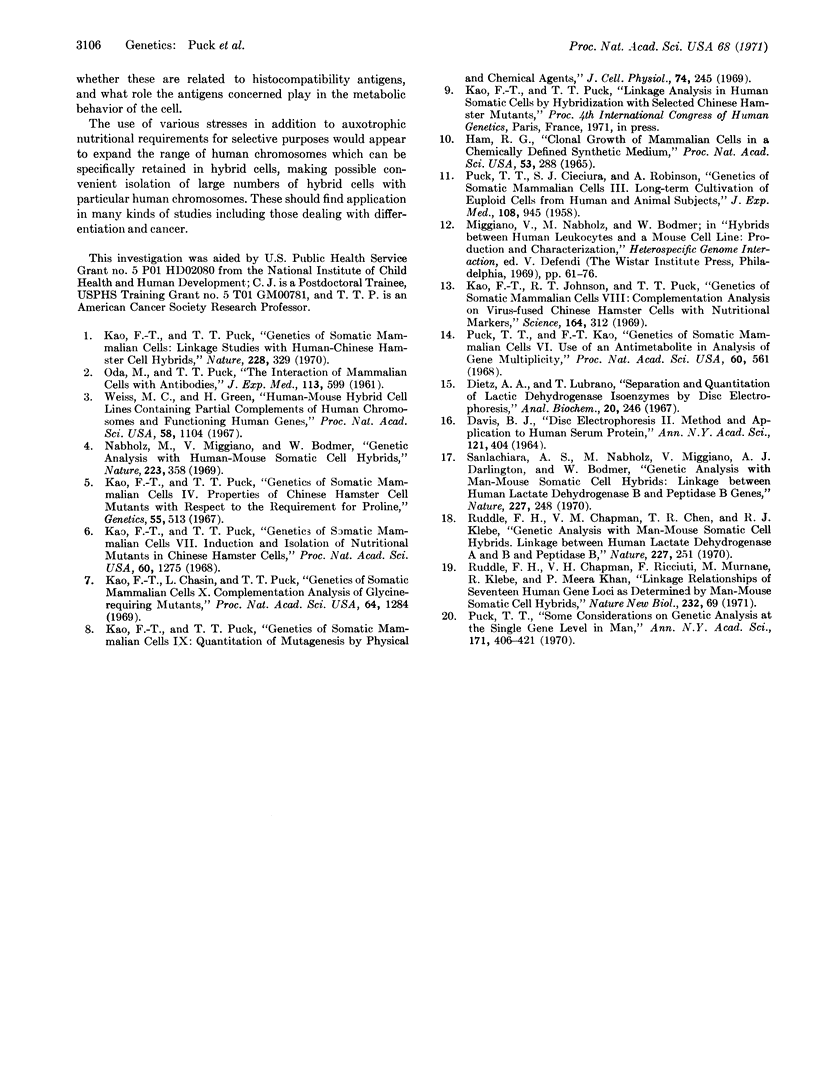
Images in this article
Selected References
These references are in PubMed. This may not be the complete list of references from this article.
- DAVIS B. J. DISC ELECTROPHORESIS. II. METHOD AND APPLICATION TO HUMAN SERUM PROTEINS. Ann N Y Acad Sci. 1964 Dec 28;121:404–427. doi: 10.1111/j.1749-6632.1964.tb14213.x. [DOI] [PubMed] [Google Scholar]
- Dietz A. A., Lubrano T. Separation and quantitation of lactic dehydrogenase isoenzymes by disc electrophoresis. Anal Biochem. 1967 Aug;20(2):246–257. doi: 10.1016/0003-2697(67)90030-9. [DOI] [PubMed] [Google Scholar]
- HAM R. G. CLONAL GROWTH OF MAMMALIAN CELLS IN A CHEMICALLY DEFINED, SYNTHETIC MEDIUM. Proc Natl Acad Sci U S A. 1965 Feb;53:288–293. doi: 10.1073/pnas.53.2.288. [DOI] [PMC free article] [PubMed] [Google Scholar]
- Kao F. T., Johnson R. T., Puck T. T. Complementation analysis on virus-fused Chinese hamster cells with nutritional markers. Science. 1969 Apr 18;164(3877):312–314. doi: 10.1126/science.164.3877.312. [DOI] [PubMed] [Google Scholar]
- Kao F. T., Puck T. T. Genetics of somatic mammalian cells, VII. Induction and isolation of nutritional mutants in Chinese hamster cells. Proc Natl Acad Sci U S A. 1968 Aug;60(4):1275–1281. doi: 10.1073/pnas.60.4.1275. [DOI] [PMC free article] [PubMed] [Google Scholar]
- Kao F. T., Puck T. T. Genetics of somatic mammalian cells. IV. Properties of Chinese hamster cell mutants with respect to the requirement for proline. Genetics. 1967 Mar;55(3):513–524. doi: 10.1093/genetics/55.3.513. [DOI] [PMC free article] [PubMed] [Google Scholar]
- Kao F. T., Puck T. T. Genetics of somatic mammalian cells. IX. Quantitation of mutagenesis by physical and chemical agents. J Cell Physiol. 1969 Dec;74(3):245–258. doi: 10.1002/jcp.1040740305. [DOI] [PubMed] [Google Scholar]
- Kao F., Chasin L., Puck T. T. Genetics of somatic mammalian cells. X. Complementation analysis of glycine-requiring mutants. Proc Natl Acad Sci U S A. 1969 Dec;64(4):1284–1291. doi: 10.1073/pnas.64.4.1284. [DOI] [PMC free article] [PubMed] [Google Scholar]
- Káo F. T., Puck T. T. Genetics of somatic mammalian cells: linkage studies with human-Chinese hamster cell hybrids. Nature. 1970 Oct 24;228(5269):329–332. doi: 10.1038/228329a0. [DOI] [PubMed] [Google Scholar]
- Nabholz M., Miggiano V., Bodmer W. Genetic analysis with human--mouse somatic cell hybrids. Nature. 1969 Jul 26;223(5204):358–363. doi: 10.1038/223358a0. [DOI] [PubMed] [Google Scholar]
- ODA M., PUCK T. T. The interaction of mammalian cells with antibodies. I. J Exp Med. 1961 Mar 1;113:599–610. doi: 10.1084/jem.113.3.599. [DOI] [PMC free article] [PubMed] [Google Scholar]
- PUCK T. T., CIECIURA S. J., ROBINSON A. Genetics of somatic mammalian cells. III. Long-term cultivation of euploid cells from human and animal subjects. J Exp Med. 1958 Dec 1;108(6):945–956. doi: 10.1084/jem.108.6.945. [DOI] [PMC free article] [PubMed] [Google Scholar]
- Puck T. T., Kao F. T. Genetics of somatic mammalian cells, VI, use of an antimetabolite in analysis of gene multiplicity. Proc Natl Acad Sci U S A. 1968 Jun;60(2):561–568. doi: 10.1073/pnas.60.2.561. [DOI] [PMC free article] [PubMed] [Google Scholar]
- Ruddle F. H., Chapman V. M., Chen T. R., Klebe R. J. Genetic analysis with man-mouse somatic cell hybrids. Linkage between human lactate dehydrogenase A and B and peptidase B. Nature. 1970 Jul 18;227(5255):251–257. doi: 10.1038/227251a0. [DOI] [PubMed] [Google Scholar]
- Santachiara A. S., Nabholz M., Miggiano V., Darlington A. J., Bodmer W. Genetic analysis with man-mouse somatic cell hybrids. Linkage between human lactate dehydrogenase B and peptidase B genes. Nature. 1970 Jul 18;227(5255):248–251. doi: 10.1038/227248a0. [DOI] [PubMed] [Google Scholar]
- Weiss M. C., Green H. Human-mouse hybrid cell lines containing partial complements of human chromosomes and functioning human genes. Proc Natl Acad Sci U S A. 1967 Sep;58(3):1104–1111. doi: 10.1073/pnas.58.3.1104. [DOI] [PMC free article] [PubMed] [Google Scholar]



